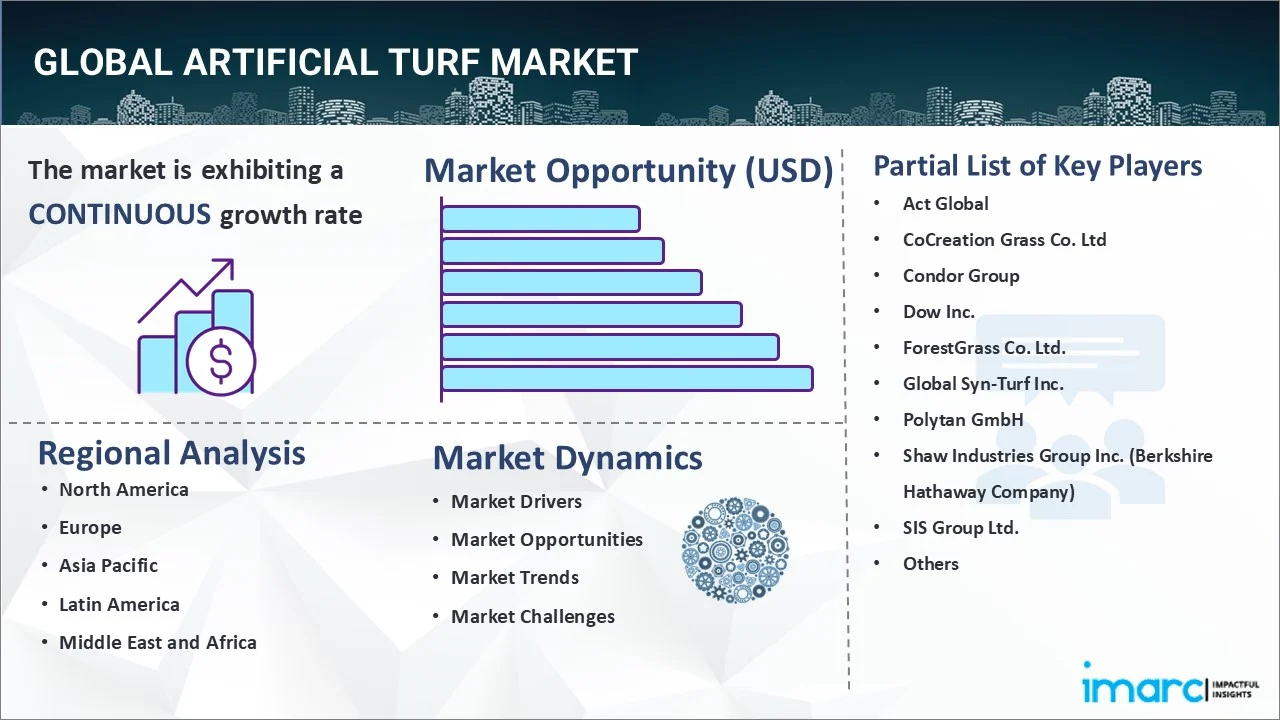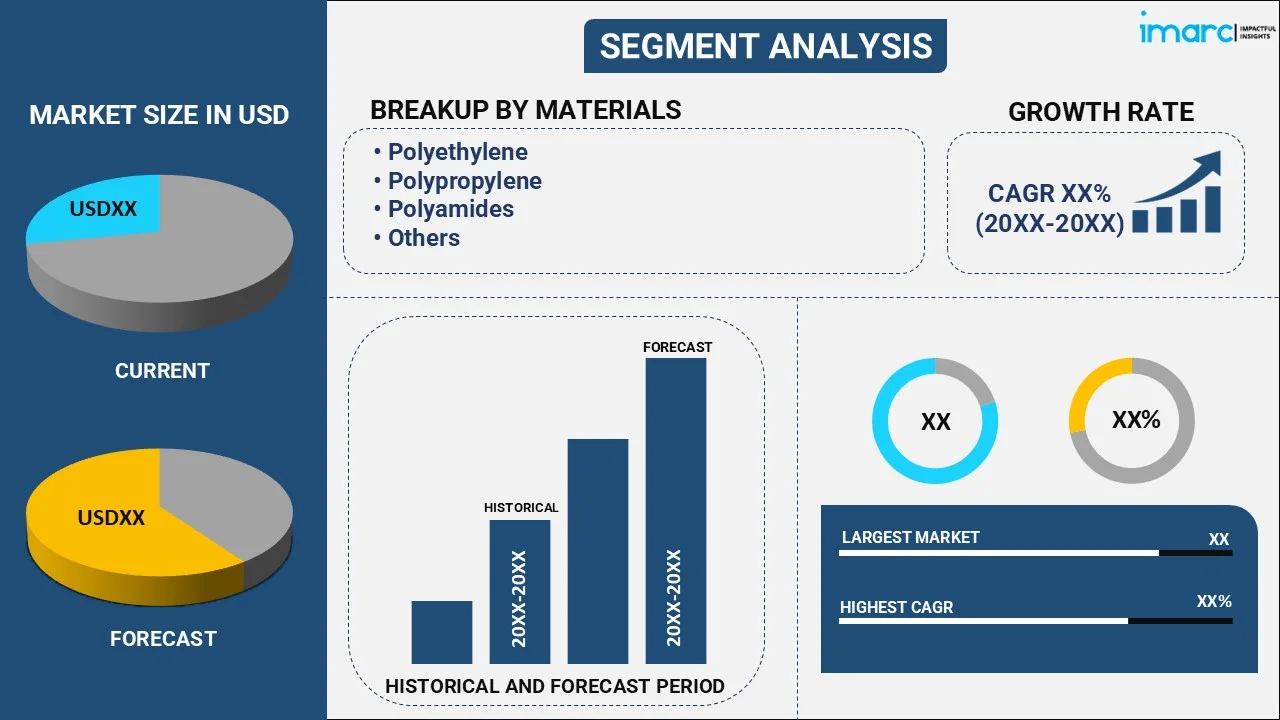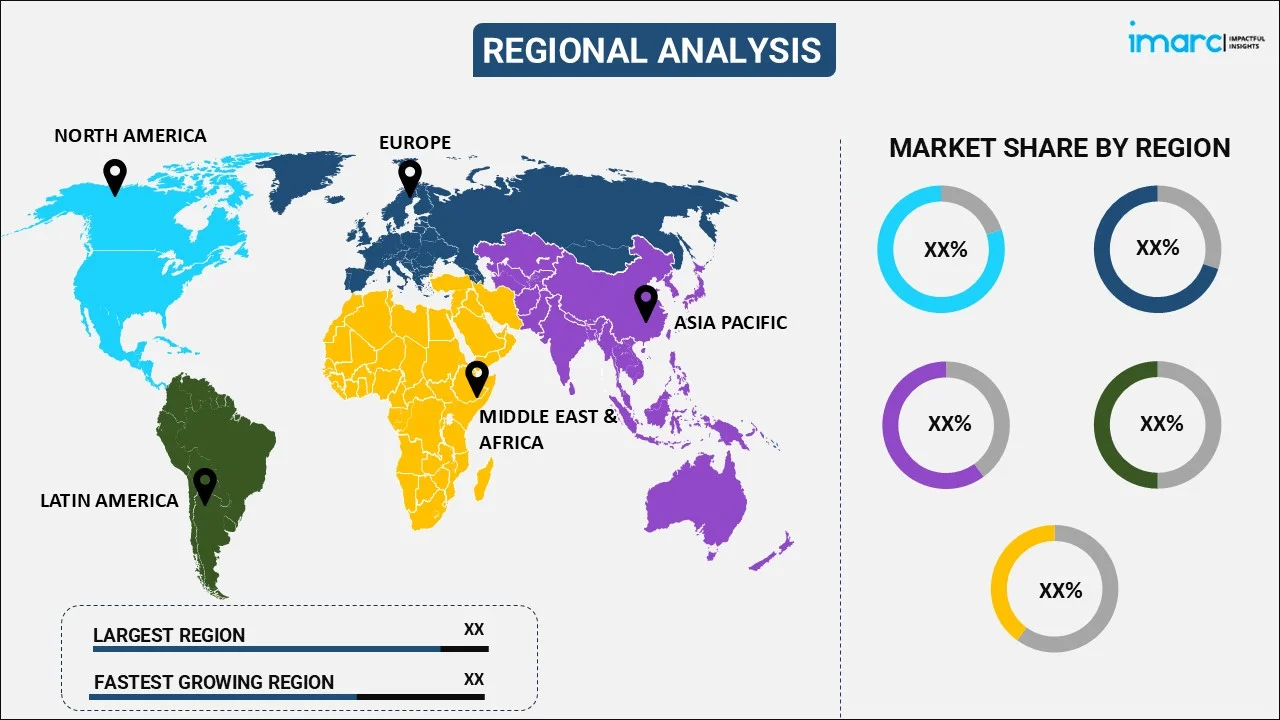
Artificial Turf Market Report by Material (Polyethylene, Polypropylene, Polyamides, and Others), Application (Household, Sports and Leisure, Restaurant and Hotels, Airports and Commercial Offices, and Others), Distribution Channel (Direct Sales/B2B, Online Stores, Specialty Stores, Convenience Stores, and Others), and Region 2025-2033
Market Overview:
The global artificial turf market size reached USD 3,751.8 Million in 2024. Looking forward, IMARC Group expects the market to reach USD 5,765.8 Million by 2033, exhibiting a growth rate (CAGR) of 4.9% during 2025-2033. The increasing applications of artificial turf in leisure and landscaping sectors, easy product availability via e-commerce platforms, and rapid urbanization are some of the major factors propelling the market.
|
Report Attribute
|
Key Statistics
|
|---|---|
|
Base Year
|
2024
|
|
Forecast Years
|
2025-2033
|
|
Historical Years
|
2019-2024
|
| Market Size in 2024 | USD 3,751.8 Million |
| Market Forecast in 2033 | USD 5,765.8 Million |
| Market Growth Rate 2025-2033 | 4.9% |
Artificial Turf Market Analysis:
- Major Market Drivers: The rising demand for cost-effective, durable, and low-maintenance outdoor flooring options represents one of the major drivers of the market. The increasing number of sports events and tournaments and unfavorable climate conditions for natural growth are escalating the demand for artificial turf.
- Key Market Trends: The increasing investment by governments of various countries across the globe in infrastructure development and constructing commercial gardens, sports complexes, and stadiums represents one of the key trends in the market. The widespread adoption of artificial turf in public spaces such as airports, restaurants, and hotels due to its water-saving properties is positively influencing the market growth.
- Geographical Trends: Europe accounted for the largest region in the artificial turf market growth. This strong sports culture and the need for reliable playing services, provided European manufacturers with a head start in the industry are driving the demand for artificial turf in the region.
- Competitive Landscape: Some of the major market players in the artificial turf industry include Act Global, CoCreation Grass Co. Ltd, Condor Group, Dow Inc., ForestGrass Co. Ltd., Global Syn-Turf Inc., Polytan GmbH, Shaw Industries Group Inc. (Berkshire Hathaway Company), SIS Group Ltd., SpectraTurf Inc. (Ecore International Inc.), Sport Group Holding GmbH, Tarkett S.A. and Koninklijke TenCate B.V., among many others.
- Challenges and Opportunities: The market faces various challenges such as environmental concerns over the disposable and recycling of non-biodegradable materials, health issues linked to the chemicals and infill used in turf production, and high initial installation costs. However, the market also faces several opportunities including technological advancements that lead to more eco-friendly and safer products and growing demand in regions with water shortages and climates unsuitable for natural grass.

Artificial Turf Market Trends:
Growing Demand for Sustainable and environment-friendly Solutions
The growing demand for sustainable and environment-friendly solutions is a major factor propelling the market. For instance, in March 2023, Encina Development Group (“Encina” or the “Company”) a producer of ISCC+ circular chemicals from end-of-life plastics, announced a new recycling partnership with Shaw Industries Group, Inc. (“Shaw”), a global flooring manufacturer. Under the agreement, Shaw will provide Encina with more than 2 million pounds of waste materials from its carpet manufacturing processes annually. As awareness about environmental conservation increases, there is a rising emphasis on finding alternatives that reduce the ecological footprint, which in turn has augmented the demand for artificial turf. Similarly, in April 2024, Dow announced two new partnerships at Chinaplas 2024 to develop solutions that meet both performance and circular demand. In collaboration with Dow, Sealed Air commercialized an e-commerce packaging with increased recycled content. With the partnership, both parties will work together to develop more e-commerce packaging using Dow’s REVOLOOP post-consumer recycled (PCR) resins, offering an effective way to protect products while also reducing carbon footprint through less use of virgin plastics. This is expected to boost the artificial turf market forecast over the coming years.
Rise in Urbanization and Limited Space Availability
The rise in urbanization and limited space availability are significant factors contributing to the increasing demand for artificial turf in the global market. According to the World Bank, today, some 56% of the world's population-2.4 billion inhabitants live in cities. This trend is expected to continue, with the urban population more than doubling its current size by 2050, at which point nearly seven of 10 people will live in cities. This is further influencing the artificial turf market statistics. As cities experience rapid growth and become more densely populated, the availability of expansive outdoor spaces, including traditional lawns, becomes limited. This creates a need for innovative solutions that can maximize the utilization of available space while still providing green and aesthetically appealing environments, thus fueling the market growth.
Advancements in Technology and Product Innovations
Manufacturers are continually focusing on product innovations to improve the quality, durability, and visual appeal of artificial turf, making it an increasingly attractive choice for various applications. Artificial turf now features advanced UV stabilization technology that minimizes color fading caused by prolonged exposure to sunlight. This ensures that the turf retains its vibrant and natural-looking appearance for an extended period, maintaining its aesthetic appeal over time. Innovative design features, such as perforations and advanced backing materials, facilitate efficient water drainage, preventing water accumulation on the surface. For instance, in October 2023, Condor Grass introduced a groundbreaking world-first with color shift technology. Years of research and extensive testing have led to a revolutionary type of artificial grass that reacts to outdoor temperatures on changes in colors with the seasons. In doing so, the Hasselt-based company adds additional natural properties to artificial grass.
Artificial Turf Industry Segmentation:
IMARC Group provides an analysis of the key trends in each segment of the global artificial turf market report, along with forecasts at the global, regional, and country levels from 2025-2033. Our report has categorized the market based on material, application, and distribution channel.
Breakup by Material:

- Polyethylene
- Polypropylene
- Polyamides
- Others
Polyethylene dominates the market
The report has provided a detailed breakup and analysis of the market based on the material. This includes polyethylene, polypropylene, polyamides, and others. According to the report, polyethylene represented the largest segment.
Polyethylene is the most widely used material in artificial turf due to several key advantages in durability, performance, and aesthetics. It is known for its exceptional resilience and resistance to wear and tear. This makes it highly suitable for high-traffic areas such as sports fields and playgrounds. The rising adoption of polyethylene fibers, which can withstand heavy use, including frequent foot traffic and sports activities, without losing their shape or integrity, is contributing to the market growth. This durability ensures that the artificial turf maintains its appearance and performance over an extended period, reducing the need for frequent replacement or repair. Furthermore, polyethylene is gaining popularity for its softness and natural-looking texture. The fibers are designed to replicate the appearance and feel of real grass, providing a lush and realistic surface. Apart from this, the rising adoption of polyethylene-based artificial turf, particularly in sports where players may come into direct contact with the turf as it offers users a comfortable and enjoyable experience, is propelling the market growth.
Breakup by Application:
- Household
- Sports and Leisure
- Restaurant and Hotels
- Airports and Commercial Offices
- Others
Sports and Leisure represent the largest application segment
A detailed breakup and analysis of the market based on the application has also been provided in the report. This includes household, sports and leisure, restaurant and hotels, airports and commercial offices, and others. According to the report, sports and leisure accounted for the largest market share.
The main factors that are driving the growth of this segment are enhanced performance, safety, weather resilience, and cost efficiency of artificial turf. Moreover, the rising awareness about the advantages of artificial turf has accelerated the product adoption rate in sports fields, stadiums, and recreational areas across the globe. Additionally, natural grass fields struggle to withstand such intensive use, leading to quick deterioration and the need for frequent maintenance. In line with this, the rising demand for artificial turf, which offers a durable and long-lasting solution that can withstand high foot traffic and intensive activities without compromising performance, is another major growth-inducing factor. Besides this, artificial turf provides consistent playing characteristics, ensuring uniform ball bounce and predictable footing for athletes across different sports, which is propelling the market growth.
Breakup by Distribution Channel:
- Direct Sales/B2B
- Online Stores
- Specialty Stores
- Convenience Stores
- Others
A detailed breakup and analysis of the market based on the distribution channel has also been provided in the report. This includes direct sales/B2B, online stores, specialty stores, convenience stores, and others.
Direct sales in the business-to-business (B2B) context refer to the process of selling products or services directly to other businesses rather than selling them through intermediaries such as retailers. B2B direct sales involve building relationships with potential buyers, understanding their needs, and providing tailored solutions to meet those needs.
Whereas, online stores, also known as e-commerce stores or online shops, are websites or virtual platforms where consumers and businesses are purchasing artificial turf products over the Internet. This channel also provides customers with convenience, as they can easily compare different products and prices.
Specialty stores, also referred to as niche stores, are typically physical retail locations that specialize in home improvement or garden supplies. Customers often prefer this channel when they want to see and feel the product before purchasing.
Breakup by Region:

- North America
- United States
- Canada
- Asia-Pacific
- China
- Japan
- India
- South Korea
- Australia
- Indonesia
- Others
- Europe
- Germany
- France
- United Kingdom
- Italy
- Spain
- Russia
- Others
- Latin America
- Brazil
- Mexico
- Others
- Middle East and Africa
Europe exhibits a clear dominance, accounting for the largest artificial turf market share
The report has also provided a comprehensive analysis of all the major regional markets, which include North America (the United States and Canada); Asia Pacific (China, Japan, India, South Korea, Australia, Indonesia, and others); Europe (Germany, France, the United Kingdom, Italy, Spain, Russia, and others); Latin America (Brazil, Mexico, and others); and the Middle East and Africa. According to the report, Europe was the largest market for artificial turfs.
Europe exhibits a clear dominance in the market due to a combination of factors. The region's early adoption of artificial turf, driven by a strong sports culture and the need for reliable playing surfaces, provided European manufacturers with a head start in the industry. Stringent regulations and standards for sports field construction and maintenance in Europe have further bolstered the reputation of European artificial turf, ensuring compliance with safety and performance criteria. For instance, the biggest catalyst for the expansion of sports infrastructure is reportedly international tournaments. Examples cited by FIFA include the expansion of the MPHPAreana for EURO 2024 All the construction of the new Casement Park for EURO 2028.The growing focus on environmental sustainability, technological advancements, and successful export strategies across the region have contributed to its market dominance. However, the competitive landscape may evolve in the future as other regions show increased growth and innovation in the market.
Competitive Landscape:
The market is experiencing steady growth with an increase in number of sports and recreations areas across the globe coupled with rise in participation of individuals in sports activities due to rising health and fitness awareness. The market is witnessing a significant increase in research and development (R&D) initiatives as well as investments resulting in improved features, a better supply chain as well as the use of new materials for manufacturing high quality products at lower costs. We expect the market to witness new entrants, consolidation of product portfolios, and a surge in strategic collaborations among key players to drive healthy competition within the domain.
The report has provided a comprehensive analysis of the competitive landscape in the market. Detailed profiles of all major companies have also been provided. Some of the key players in the market include:
- Act Global
- CoCreation Grass Co. Ltd
- Condor Group
- Dow Inc.
- ForestGrass Co. Ltd.
- Global Syn-Turf Inc.
- Polytan GmbH
- Shaw Industries Group Inc. (Berkshire Hathaway Company)
- SIS Group Ltd.
- SpectraTurf Inc. (Ecore International Inc.)
- Sport Group Holding GmbH
- Tarkett S.A.
- Koninklijke TenCate B.V.
(Kindly note that this only represents a partial list of companies, and the complete list has been provided in the report.)
Recent Developments:
- In December 2022, Co Creation Grass Co. Ltd. delivered two FIFA quality pro fields for capital FC in the USA. These two certified fields stand out as top-tier installations in North and Central America. CFC boasts the privilege of having two out of the eleven FIFA Quality Pro-rated turf fields in the United States, as well as a remarkable total of eighteen fields in the entire CONCACAF region.
- In November 2022, B.I.G. announced that it had signed an agreement with the US headquarters synthetic turf manufacturer Act Global to acquire its complete range of activities. Through this acquisition, B.I.G. strengthens its position in the global artificial grass market, especially in the sports segment.
- In June 2022, SpectraTurf announced the launch of a new upcycling playground program focused on children’s safety and the Planet. This program will certify that 100% of the playground surfacing materials installed will be upcycled at the end of the playground's life and the tear-outs will not be taken to landfills.
Artificial Turf Market Report Scope:
| Report Features | Details |
|---|---|
| Base Year of the Analysis | 2024 |
| Historical Period | 2019-2024 |
| Forecast Period | 2025-2033 |
| Units | Million USD |
| Scope of the Report | Exploration of Historical and Forecast Trends, Industry Catalysts and Challenges, Segment-Wise Historical and Predictive Market Assessment:
|
| Materials Covered | Polyethylene, Polypropylene, Polyamides, Others |
| Applications Covered | Household, Sports and Leisure, Restaurant and Hotels, Airports and Commercial Offices, Others |
| Distribution Channels Covered | Direct Sales/B2B, Online Stores, Specialty Stores, Convenience Stores, Others |
| Regions Covered | Asia Pacific, Europe, North America, Latin America, Middle East and Africa |
| Countries Covered | United States, Canada, Germany, France, United Kingdom, Italy, Spain, Russia, China, Japan, India, South Korea, Australia, Indonesia, Brazil, Mexico |
| Companies Covered | Act Global, CoCreation Grass Co. Ltd, Condor Group, Dow Inc., ForestGrass Co. Ltd., Global Syn-Turf Inc., Polytan GmbH, Shaw Industries Group Inc. (Berkshire Hathaway Company), SIS Group Ltd., SpectraTurf Inc. (Ecore International Inc.), Sport Group Holding GmbH, Tarkett S.A., Koninklijke TenCate B.V., etc. |
| Customization Scope | 10% Free Customization |
| Post-Sale Analyst Support | 10-12 Weeks |
| Delivery Format | PDF and Excel through Email (We can also provide the editable version of the report in PPT/Word format on special request) |
Key Benefits for Stakeholders:
- IMARC’s report offers a comprehensive quantitative analysis of various market segments, historical and current market trends, market forecasts, and dynamics of the artificial turf market from 2019-2033.
- The research study provides the latest information on the market drivers, challenges, and opportunities in the global artificial turf market.
- The study maps the leading, as well as the fastest-growing, regional markets. It further enables stakeholders to identify the key country-level markets within each region.
- Porter's five forces analysis assist stakeholders in assessing the impact of new entrants, competitive rivalry, supplier power, buyer power, and the threat of substitution. It helps stakeholders to analyze the level of competition within the artificial turf industry and its attractiveness.
- Competitive landscape allows stakeholders to understand their competitive environment and provides an insight into the current positions of key players in the market.
Key Questions Answered in This Report
The global artificial turf market was valued at USD 3,751.8 Million in 2024.
We expect the global artificial turf market to exhibit a CAGR of 4.9% during 2025-2033.
The growing prominence of artificial turf for landscaping owing to its high durability, low maintenance, aesthetic appeal, eco-friendly nature, and improved resistance to wear and tear, is primarily driving the global artificial turf market.
The sudden outbreak of the COVID-19 pandemic has led to the changing consumer inclination from conventional brick-and-mortar distribution channels towards online retail platforms for the purchase of artificial turf.
Based on the material, the global artificial turf market has been segmented into polyethylene, polypropylene, polyamides, and others. Currently, polyethylene holds the majority of the total market share.
Based on the application, the global artificial turf market can be divided into household, sports and leisure, restaurant and hotels, airports and commercial offices, and others. Among these, sports and leisure exhibits a clear dominance in the market.
On a regional level, the market has been classified into North America, Asia-Pacific, Europe, Latin America, and Middle East and Africa, where Europe currently dominates the global market.
Some of the major players in the global artificial turf market include Act Global, CoCreation Grass Co. Ltd, Condor Group, Dow Inc., ForestGrass Co. Ltd., Global Syn-Turf Inc., Polytan GmbH, Shaw Industries Group Inc. (Berkshire Hathaway Company), SIS Group Ltd., SpectraTurf Inc. (Ecore International Inc.), Sport Group Holding GmbH, Tarkett S.A. and Koninklijke TenCate B.V.
Need more help?
- Speak to our experienced analysts for insights on the current market scenarios.
- Include additional segments and countries to customize the report as per your requirement.
- Gain an unparalleled competitive advantage in your domain by understanding how to utilize the report and positively impacting your operations and revenue.
- For further assistance, please connect with our analysts.
 Inquire Before Buying
Inquire Before Buying
 Speak to an Analyst
Speak to an Analyst
 Request Brochure
Request Brochure
 Request Customization
Request Customization




.webp)




.webp)












